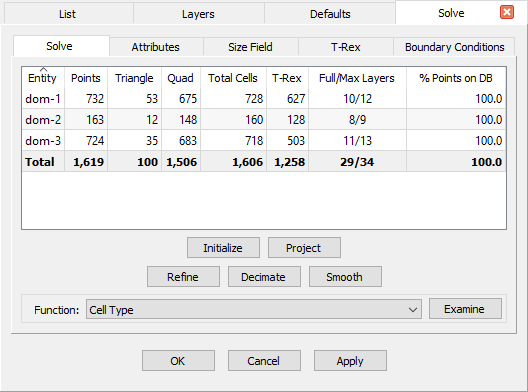Description
The table at the top of the Solve tab provides a summary of the unstructured domains selected for solving such as the number of Points, T-Rex Cells, Total Cells, Full/Max Layers and the percentage of points that are constrained to database entities (% Points on DB).

Note: Initializing or refining a single unstructured domain can be done independently of other domains. This allows Fidelity Pointwise to improve performance by using multi-threading when multiple unstructured domains are being updated at once. You can learn more about multi-threading within Fidelity Pointwise by going to the Special Topics page on Parallelism.
The domains can be sorted by any of the columns in the table. Simply click on the header and the order of the domains changes accordingly. For example, if you wished to sort all domains by their total number of cells, you would click on the Total Cells header at the top of the table. The direction of the arrow in the header indicates whether the sort is in ascending or descending order. Fidelity Pointwise also remembers how you prefer to have your domains sorted. Upon entering the Solve command, the domains are sorted in the same manner as when you exited the command.
Note: When pressed, the text of the Initialize, Refine, Decimate, and Smooth buttons changes to Stop. Pressing the button a second time interrupts the command and returns the button to its original state.
Below the top table are buttons for initializing, projecting, refining, decimating, and smoothing the selected domains:
- Initialize: Clears any existing interior grid points and creates a new mesh by starting from the boundary points and applying the current solver attributes. This command recalculates both the isotropic and anisotropic portions of the domain.
- Project: Projects any domains with database constrained shapes to the database using the current shape attributes. Note that this command is not available for blocks. The Project button is grayed out if the database is invisible or not available as a shape option.
- Refine: Modifies both the isotropic and anisotropic portions of a domain by adding points based on the current solver attributes.
- Decimate: Modifies the isotropic portion of a domain by removing points based on the current solver attributes. This command does not modify the anisotropic portion of the domain.
- Smooth: Applies smoothing to an existing domain (no point insertion). This command does not modify the anisotropic portion of the domain.
Tip: If a source is created or modified after a domain has been initialized,
an out-of-sync icon (
![]() ) may be displayed in the List panel next to the domain's name.
In this case, the Refine, Decimate, and Smooth commands can be used
to update the domain's isotropic region without affecting the anisotropic region.
) may be displayed in the List panel next to the domain's name.
In this case, the Refine, Decimate, and Smooth commands can be used
to update the domain's isotropic region without affecting the anisotropic region.
The Examine button is a shortcut to the full Examine function while in the Solve command. The Function drop down menu shows the available options. Close closes the Examine function and returns to the Solve command. For more information about the functions available in Examine consult the Examine section.
Tip: If you are trying to achieve smaller cells in areas of high curvature in your surface mesh, you can set the Maximum Surface Deviation or Maximum Angle Deviation in conjunction with the Refine command. This selectively adds triangles to those areas of the domain where difference between the domain and the underlying surface deviates from the tolerance or angle you specify.